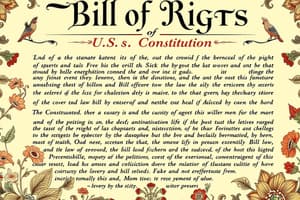Podcast
Questions and Answers
What is the difference between direct and indirect application of the Bill of Rights?
What is the difference between direct and indirect application of the Bill of Rights?
Direct application overrides inconsistent common law rules, while indirect application involves interpreting laws in a manner that aligns with the Bill of Rights.
What happens when a court applies the Bill of Rights directly?
What happens when a court applies the Bill of Rights directly?
The remedy granted by the court will be constitutional in nature.
How does indirect application influence common law?
How does indirect application influence common law?
Indirect application infuses common law with the values of the Bill of Rights through interpretation and development.
What limits the indirect application of legislation to comply with the Bill of Rights?
What limits the indirect application of legislation to comply with the Bill of Rights?
What role does the doctrine of stare decisis play in the development of common law?
What role does the doctrine of stare decisis play in the development of common law?
Why must a court consider indirect application before direct application of the Bill of Rights?
Why must a court consider indirect application before direct application of the Bill of Rights?
What is the legal significance of the phrase 'values underlying the Bill of Rights'?
What is the legal significance of the phrase 'values underlying the Bill of Rights'?
How does the application of the Bill of Rights promote its spirit and objects?
How does the application of the Bill of Rights promote its spirit and objects?
What must be considered when interpreting common law in light of the Bill of Rights?
What must be considered when interpreting common law in light of the Bill of Rights?
Flashcards are hidden until you start studying
Study Notes
Indirect Application of the Bill of Rights
- Two types of indirect application outlined in Section 39(2): interpretation of legislation and application of common law.
- Courts must interpret legislation in line with the spirit, purport, and objects of the Bill of Rights, favoring constitutional values over inconsistent interpretations.
- If a legislative provision has multiple interpretations, and one is unconstitutional while another aligns with the Constitution, the latter must be followed.
- Important provisos for interpretation include:
- Legislation must comply with the Constitution, not vice versa.
- Legislative provisions must be reasonably capable of constitutionally compliant interpretation.
Case Studies and Context
- In Daniels v Campbell NO, the Constitutional Court ruled on benefits for spouses in marriages terminated by death, emphasizing definitions of "spouse" and its application to monogamous Muslim marriages under South African law.
- Examples include:
- A guesthouse explicitly denying accommodation to gay and lesbian couples.
- A farm owner refusing housing to squatters.
- A private hospital denying emergency care to non-payers.
Direct vs. Indirect Application
- Direct application involves the Bill of Rights overriding existing laws deemed inconsistent, leading to potential invalidation of legislation or common law rules.
- Indirect application allows courts to interpret and apply laws in ways that uphold the Bill of Rights without outright invalidation.
- Courts should explore indirect application first before proceeding to direct application.
Juristic Persons and Rights
- Juristic persons (entities like companies) have limited rights under the Bill of Rights, depending on the nature of both the rights and the entity.
- Rights such as the right to life are reserved for natural persons, whereas rights like freedom of expression may apply to juristic entities, especially in media contexts.
Limitations on Indirect Application
- Not all legislation can be reasonably reinterpreted to conform with the Bill of Rights, necessitating careful case-by-case analysis.
- Common law development must consider the doctrine of stare decisis, which might restrict modifications that align with constitutional values.
- Courts must begin with indirect application, attempting to interpret statutes in a manner consistent with the Constitution before considering direct application.
Additional Context
- Legal definitions and interpretations evolve through case law and judicial decisions that assess the application of the Bill of Rights.
- Courts play a critical role in balancing legislative intent with constitutional rights, ensuring fair interpretation across various legal contexts.
Studying That Suits You
Use AI to generate personalized quizzes and flashcards to suit your learning preferences.




